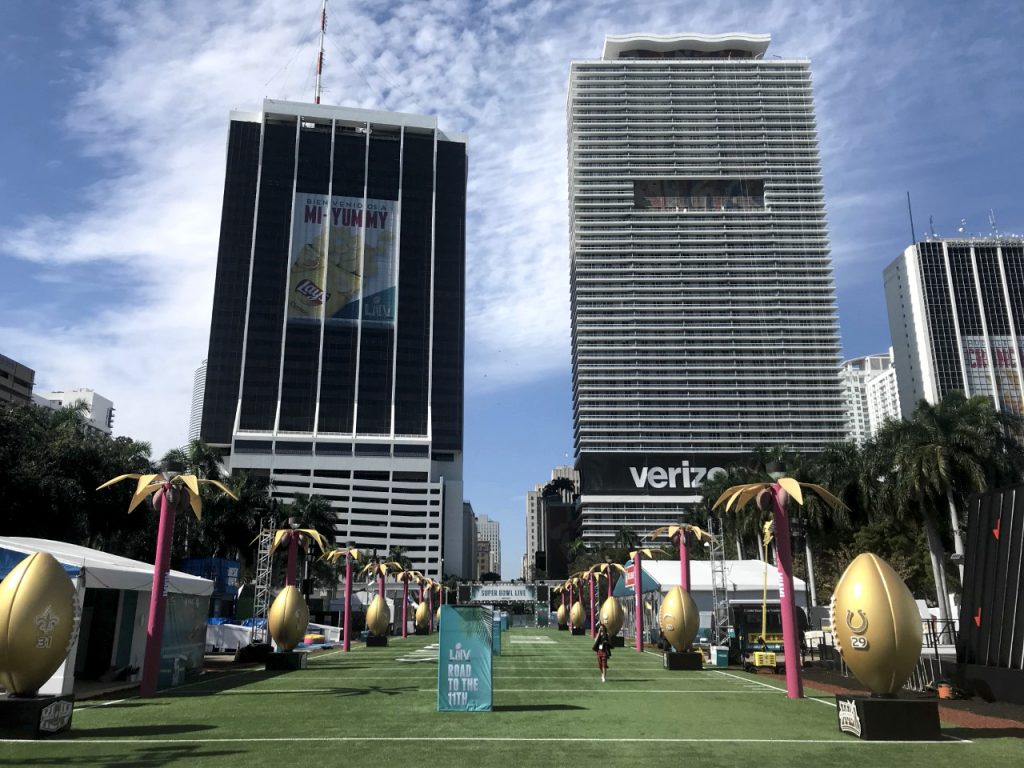
By Douglas Hanks

Bring Super Bowl to the Miami area, and Pitbull will surely have a role. And, yes, about an hour before kickoff, there was Miami’s go-to local celebrity dancing with comedian Rob Riggle and samba dancers around a mansion’s pool.
The theme of the bit on Fox’s pre-game broadcast was how to “throw the best party Miami has ever seen.” It was an instance of Super Bowl’s setting enjoying a star turn amid the attention that comes with the country’s most popular sporting event.
Fox Sports picked South Beach for its largest Super Bowl broadcasting complex ever, with two stages for anchors and a miniature football field in the middle for analysts’ demonstration plays. Fox News set up shop there, too, with its popular “Fox and Friends” morning show having Miami Mayor Francis Suarez on for a live interview Friday.
Outside the studios, Fox turned Lummus Park into a Super Bowl “village,” with a Ferris wheel, LIV props for photo backdrops and a spider cam on wires above to broadcast the South Beach bustle off Ocean Drive.
“It’s priceless media coverage,” said William Talbert, president of the Greater Miami Convention and Visitors Bureau. “It’s at least a week of 24/7 Miami. … The pre-show was a Miami infomercial.”
The first that viewers heard from Shakira during the halftime show were “Hola, Miami.” She then joined Jennifer Lopez in a halftime show hailed as a celebration of Latin beats and pride. For Alyce Robertson, former director of Miami’s Downtown Development Authority, the spectacle meshed with the setting. “The halftime show was so Miami,” she said.
As Fox cut to commercial break at halftime, the broadcast shifted briefly to Ocean Drive at night, with its trademark South Beach neon and a packed sidewalk restaurant. In the third quarter, an aerial camera hovered above a gleaming skyline along Miami’s Brickell Avenue, where Brickell Key meets Biscayne Bay.
“They’re the money shot for Miami,” Roberto Schaps, founder of the Rebrand Miami marketing firm, said of the cutaway to Brickell and the downtown lights. “Everyone knows Ocean Drive, so it was good they included” Miami.
The cutaways were a welcome addition for tourism boosters after Super Bowl’s last appearance in Miami Gardens, when the first live shot from CBS was of Bourbon Street minutes after the New Orleans Saints beat the Indianapolis Colts in Super Bowl 44. There wasn’t a single shot of Miami, Miami Beach or Miami Gardens that year.
Officially, Miami Gardens got the most screen time in Super Bowl 54, thanks to frequent aerial shots of Hard Rock Stadium. But the Fox broadcasters often overlooked Miami Gardens, the Super Bowl’s actual host city. “These teams are ready to roll here in Miami,” Fox sportscaster Joe Buck said to start the game’s coverage.
It was the first of several geographical oversights that touched on a sore spot for Super Bowl, which focused most of the celebration, spending and attention outside Miami Gardens in the week leading up to the game. That includes the NFL’s Super Bowl Experience expo at the Miami Beach Convention Center and the local Host Committee’s free Super Bowl Live festival at downtown Miami’s Bayfront Park.
“The pictures of Super Bowl I’ve seen very frequently are South Beach and downtown Miami’s Bayfront Park,” said Steve Gallon, the Miami-Dade school board member representing Miami Gardens. ““The event is in Miami Gardens. But if you see local and national news, that’s not what is highlighted.”
“This can’t be simply about symbolism,” Gallon said, “but about the substance of a measurable economic and marketing benefit to the very city that is hosting the Super Bowl.”
Miami Gardens was not totally snubbed during the broadcast. Buck seemed to correct course in the second half, naming the host city multiple times. When Chiefs player Rashad Fenton made a play, Bucked noted he was from “Miami Gardens, Florida, which where we are sitting right now.”
Free publicity and increased spending are the main selling points for advocates of Super Bowl, which costs local governments millions of dollars to cover expenses the NFL won’t. For Miami-Dade in 2020, that included $1 million for hotel rooms housing players for the Chiefs and 49ers, free accommodations that the NFL demands from local organizers.
Miami’s Downtown Development Authority, a taxing district that promotes downtown, organized a media trip in November to seed Super Bowl stories months later. The itinerary included tours of the Perez Art Museum of Miami and the Frost Science Museum, along with stops at a Miami Heat game and rides on both Miami-Dade’s free Metromover train downtown and the new Brightline train running between West Palm Beach and Miami.
A summary of the trip by the authority’s public relations firm, Schwartz Media Strategies, said the objective was to “leverage Super Bowl LIV as a platform for securing coverage … showcasing the transformation of downtown Miami over the last 10 years.”
Talbert, the tourism bureau chief, said Super Bowl shouldn’t be scored by a tally of cutaways during the game. He said the game’s arrival gives Miami a chance to show off its progress against where it was the last time the Super Bowl was in town. Those include Metrorail’s new Orange Line to Miami International Airport, and an option for cruise traffic to bypass downtown.
“Ten years ago, there wasn’t a rail connection to the airport. Ten years ago there wasn’t a tunnel to the port. There wasn’t PAMM and there wasn’t Frost,” he said. “It’s basically a brand-new destination.”
Read more via the Miami Herald here.




 See More Blogs
See More Blogs
Comments